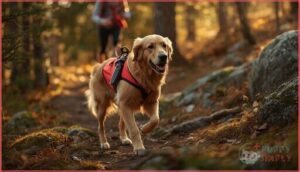This site is supported by our readers. We may earn a commission, at no cost to you, if you purchase through links.
Your Labrador keeps pulling you toward the trailhead while your neighbor’s Pomeranian can barely make it around the block. That difference isn’t just about size—it’s about breeding, physiology, and whether a dog’s ancestors were built for covering ground.
The best hiking dogs combine endurance that lets them tackle 5–10 miles after proper conditioning, temperaments stable enough to handle wildlife encounters, and physical traits suited to the terrain you love.
Finding the right trail companion means matching breed characteristics to your outdoor style, whether you’re traversing alpine switchbacks in January or desert paths in August. The breeds that excel share specific traits worth understanding before you lace up your boots.
Table Of Contents
Key Takeaways
- The best hiking dogs combine endurance for 5-10 mile treks, stable temperaments for wildlife encounters, and physical traits matched to your terrain—whether you’re tackling alpine switchbacks or desert paths.
- Medium-sized breeds between 25-50 pounds balance stamina and joint health best, while larger breeds face 23% higher chronic injury rates and smaller breeds struggle with rough ground and load carrying.
- Build your dog’s trail readiness gradually through proper conditioning, starting puppies with 15-30 minute walks and waiting until 18 months for larger breeds, while providing high-protein snacks that meet 25% extra calorie needs.
- Mixed breeds and rescues make excellent hiking partners with 28% lower annual vet costs and superior genetic diversity, though adult rescues need 8-12 weeks of structured obedience training for reliable recall.
Key Traits of The Best Hiking Dogs
Not every dog is built for the trail. The best hiking companions share a handful of essential traits that help them tackle challenging terrain and keep up with your pace.
Here’s what separates a great trail dog from one that’s better suited for the couch.
Energy and Stamina
Energy and stamina separate trail-ready breeds from backyard loungers. Most dogs can handle 5–10 miles after conditioning, but working breeds like Huskies routinely cover 100 miles daily in sled races. A dog’s caloric expenditure can quadruple during strenuous hikes, demanding proper nutrition.
A dog’s physical condition matters and impacts their hiking ability. Watch for fatigue indicators—curled tongue, seeking shade—to respect stamina limits and prevent overexertion on challenging terrain.
Temperament and Trainability
High energy isn’t enough—your dog needs the right temperament and trainability to navigate trails safely. Labrador Retrievers show 92% command reliability, making recall on challenging terrain dependable. Australian Shepherds score 88% in problem-solving skills, adapting quickly to obstacles. Behavioral stability matters too: Bernese Mountain Dogs maintain 91% composure with strangers and wildlife.
Bernedoodles are suitable for outdoor adventures because of their adaptable build. Learning speed and breed sociability determine whether your companion thrives outdoors or creates headaches on every hike.
Coat Type and Weather Tolerance
Trainability means little if your dog overheats in summer or shivers through winter. Double coat benefits shine in cold weather: Siberian Huskies tolerate -40°C, while single coat risks become obvious when short-haired breeds hit 41.2°C during exercise. Color and temperature link matters too—dark-coated dogs face higher hyperthermia risk. Veterinary guidelines recommend protective gear below 7°C for thin-furred breeds and limiting exertion above 20°C for thick double coats.
- Fur length affects heat retention—dense undercoats trap warmth at -50°C
- Seasonal shedding helps mountain breeds adapt between -10°C winters and 25°C summers
- Dogs and summer heat require cooling strategies for double-coated breeds like Alaskan Malamutes
Size and Physical Robustness
Beyond coat and climate, physical build determines whether your dog tolerates rocky switchbacks or needs a lift halfway through. Medium-sized breeds between 25–50 pounds balance dog stamina and terrain impact best—they cover 3–7 miles comfortably without the joint strain plaguing larger companions.
Weight and stamina connect directly: dogs over 50 pounds face shortened hiking lifespans and 23% higher chronic injury rates, while small breeds struggle with load carrying and rough ground.
Top Large Breeds for Hiking
If you’re looking for a four-legged partner who can handle long miles and rugged terrain, large breeds bring serious advantages to the trail. These dogs combine strength, endurance, and the physical build needed to tackle challenging hikes without tiring out too quickly.
Let’s look at five standout large breeds that excel on outdoor adventures.
Siberian Husky
If you’re serious about hiking with dogs, the Siberian Husky sets the bar for endurance training and dog stamina. This legendary sled dog can cover 100 miles daily for ten consecutive days when conditioned, thriving in cold weather and high altitude environments.
You’ll need to match their intense calorie needs—up to 10,000 per day during multi-day treks—but their energy levels reward dedicated adventurers.
Bernese Mountain Dog
The Bernese Mountain Dog loves cooler weather hikes, but you’ll face important trade-offs. This gentle giant tops 88 pounds, creating rescue difficulties if injured on remote trails.
- Hip and elbow dysplasia affects 12-36% of the breed, raising joint issues concerns
- Heat intolerance limits warm-weather excursions due to their dense coat
- Stamina limits become apparent after a few hours of hiking
- Lifespan concerns average just 7-8 years, shorter than most large breeds for hiking
Labrador Retriever
Your Labrador Retriever brings a friendly temperament and solid athleticism for moderate hikes up to 12 miles, though they’re better sprinters than ultra-distance companions. Field Labs excel over show lines with leaner builds and higher stamina.
Watch heat tolerance carefully—Labs struggle in warm conditions and perform best on temperate, shaded trails lasting 2.5 hours or less. Their water retrieving heritage makes stream crossings a bonus adventure.
Alaskan Malamute
Your Alaskan Malamute thrives where other dog breeds for hiking falter—extreme conditions that demand true grit. Weighing 75 to 95 pounds, this sled dog carries Arctic origins dating back 4,000 years, plus a double coat built for subzero adventures.
Malamutes joined Richard Byrd’s 1933 Antarctic expedition, proving endurance breeds can handle multi-day treks in the harshest terrain imaginable.
Doberman Pinscher
Your Doberman Pinscher adjusts quickly to new trails, making it one of the most adaptable working dogs for multi-day hikes. This loyal and protective dog requires altitude acclimation on high-elevation routes to prevent dehydration.
The short coat needs protection in cold weather—temperatures below freezing demand insulated gear.
Watch that prey drive closely; leash control is essential when hiking in wildlife zones, ensuring hiking safety for everyone on the trail.
Best Medium Breeds for The Trail
Medium-sized dogs hit the sweet spot for most hikers—they’re sturdy enough to handle rough terrain without the joint concerns of larger breeds, yet they pack serious endurance and agility. These dogs generally weigh between 30 and 70 pounds, making them easier to assist over obstacles or lift into your vehicle after a long day on the trail.
Here are five medium breeds that consistently prove themselves as excellent hiking partners.
Australian Shepherd
If you’re looking for Hiking Companions that bring Aussie Stamina and Trail Versatility, the Australian Shepherd stands out. These Herding dogs can handle hikes up to 15 miles once conditioned, requiring 1–2 hours of daily exercise.
Their Herding Instincts keep them alert on trails, though Coat Management matters in varying weather.
Hiking with your dog becomes simple with these Active dog breeds—just invest in proper Dog training first.
German Shorthaired Pointer
German Shorthaired Pointers combine hunting heritage with remarkable trail alertness, regularly completing 10–20 mile hikes. A well-conditioned GSP’s stamina shines on demanding terrain, and you’ll find these hunting dogs can carry packs at 10–15% body weight. Maintain joint health as they age, especially after multi-day adventures.
Your GSP on the trail:
- Sleek coat sheds rain and debris easily
- Alert ears swivel toward rustling undergrowth
- Muscular legs spring over rocky outcrops
- Focused eyes scan ahead for wildlife
- Steady breathing matches your hiking pace
Australian Cattle Dog
Australian Cattle Dogs demand 2 hours of vigorous daily exercise, making them outstanding hiking dogs with impressive dog stamina. Their herding instincts translate into cattle dog agility on challenging terrain, and these herding dogs thrive on trail activities that test both body and mind.
You’ll need smart energy management in hot climates—heat sensitivity can sideline overconfident dog breeds fast. Interactive mental challenges between hikes keep this powerhouse ready for adventure.
Weimaraner
Weimaraners bring serious trail stamina with their sporting history as adaptable hunting dogs—they clock 35 mph sprints and handle marathon hikes when properly conditioned. You’ll need to commit 2 hours daily to meet their exercise needs.
Their training acuity responds brilliantly to positive reinforcement, but watch that wanderlust potential. Solid recall training isn’t optional with these active breeds—it’s your safety net on every trail.
Portuguese Water Dog
If your trails include river crossings or lakeside routes, Portuguese Water Dogs excel beyond most breeds. Their working history as diving and retrieval dogs translates to remarkable swimming ability and trail adaptability.
You’ll need to provide at least 1 hour of daily exercise—brisk walks and running satisfy their high energy levels. Their strong owner bond reduces wanderlust risks, though coat maintenance requires regular attention to prevent matting on muddy hikes.
Small Dogs That Excel at Hiking
You don’t need a giant dog to tackle serious trails. Several small breeds pack surprising endurance, stamina, and a love for adventure into compact frames.
Here are four pint-sized powerhouses that prove size isn’t everything for hitting the hiking path.
Jack Russell Terrier
Don’t let size fool you—Jack Russell Terriers pack serious Trail Stamina. These small dog breeds regularly tackle hiking distances up to 12 miles with 2,400-foot elevation gains, thanks to their fox-hunting roots.
You’ll need to manage their strong Prey Drive with leashing, but they’ll reward you with boundless Energy and Stamina. At 13-17 pounds, breed transport is easy, and many even carry their own backpacking supplies during extended adventures.
Beagle
Beagles bring considerable cardiovascular health benefits to their scent-tracking hikes, reaching running speeds up to 20 mph on trails. Their compact build (20-25 pounds) navigates varied terrain with ease, while their scent hound instincts keep them motivated across long distances, making them superb hiking dogs.
These small dog breeds need at least one daily walk—two is ideal—to satisfy their beagle exercise needs and prevent behavioral issues.
Cairn Terrier
These hardy dog breeds deliver impressive hiking stamina, regularly completing 2 to 10-mile treks with proper rest breaks. Weighing just 13-14 pounds, Cairn Terriers offer convenient pack transport when needed. Their double coat insulation suits both cool and warm conditions, while temperament traits include above-average mental engagement.
Regular dog exercise through hiking promotes a breed lifespan reaching 16-17 years and prevents destructive behavior.
Yorkshire Terrier (with Considerations)
Yorkies need two brisk daily walks to maintain physical and mental health. At just 4-7 pounds, they’re suitable for shorter trails with frequent breaks. However, their tracheal collapse risk requires harnesses rather than collars for respiratory safety.
Small breed hiking success depends on proper acclimatization and pacing:
- Build small dog stamina gradually through progressive trail exposure
- Monitor breathing and rest frequently on elevation gains
- Use positive dog training to strengthen recall commands
- Prevent overexertion injuries through careful distance management
Endurance and Hunting Breeds for Adventure
If you’re looking for a dog that’s built to go the distance, hunting breeds are hard to beat. These dogs were bred for stamina, drive, and the kind of focus that keeps them moving through challenging terrain all day long.
Here are three breeds that bring serious endurance to every adventure.
Vizsla
If you’re after a dog that practically runs on pure adrenaline, the Vizsla delivers exceptional stamina—this breed can cover up to 40 miles in a day and sprint at 40 mph. They’re one of the top hiking dogs, but their training needs are demanding.
Watch for joint health issues, especially before maturity. Both smooth and wirehaired coat variations handle trails well, though neither loves extreme weather.
Rhodesian Ridgeback
Built like an endurance athlete, the Rhodesian Ridgeback manages 12-mile running trials while maintaining a steady 10-minute-per-mile pace. Males weigh 80–100 pounds, females 60–80 pounds—solid builds for rugged terrain. Their short coat adapts well to heat but needs extra layers in cold weather.
You’ll need consistent training to manage their independent streak and strong prey drive. Daily 45-minute sessions keep them trail-ready.
Treeing Walker Coonhound
For tracking scent trails over miles of backcountry, the Treeing Walker Coonhound brings serious hunting heritage to your pack. These 50–70-pound dogs cover ground relentlessly, though their powerful vocalization and escape artistry require secure leads.
Training challenges include managing their prey drive, but their 12–13-year lifespan and heat tolerance make them reliable companions for seasoned hikers comfortable with hunting dogs.
Mixed Breeds and Rescues for Hiking
You don’t need a purebred to find your perfect hiking partner. Mixed breeds and rescue dogs often bring the best of multiple breeds together, combining endurance, intelligence, and an eagerness to hit the trail with you.
Here’s what you need to know about choosing and preparing a rescue dog for outdoor adventures.
Benefits of Adopting Mixed Breeds
When you choose mixed breed dog adoption, you’re getting a hiking partner with serious genetic diversity that translates to adaptability benefits on the trail.
Mixed Breed Hiking Dogs usually mean reduced vet costs—up to 28% lower annually—and adoption savings of $500–$1,000 upfront.
Plus, finding the right mixed breed through dog adoption improves shelter outcomes while giving you a resilient, cost-effective companion for every adventure.
Training Adult Rescue Dogs for Hiking
Training an adult rescue dog for hiking requires patience, but it pays off. Structured obedience builds Recall Reliability in about 8–12 weeks, though off-leash work may take six months.
Start with short conditioning hikes and use Positive Reinforcement to tackle Leash Reactivity and Fear Responses.
Daily practice strengthens trail etiquette for dogs while reducing Injury Prevention risks—70% better recall within three months proves consistency works.
Assessing Suitability for Outdoor Activities
Before you hit the trail, check your dog’s fitness level and breed temperament—even rescues show hiking potential when their energy and stamina match your plans. Age factors and health conditions matter more than pedigree.
Watch for dog breed suitability indicators: sustained focus during 2-mile walks, curiosity without reactivity, and recovery under 10 minutes. Environmental risks like heat sensitivity reveal dog health limitations early.
Essential Training and Safety Tips
Getting your dog trail-ready takes more than just clipping on a leash and heading out. You need to build their stamina gradually, teach them proper trail behavior, and make sure they’re healthy enough for the adventure ahead.
Here’s what you should focus on before hitting the trails with your four-legged companion.
Building Endurance Safely
You can’t rush endurance—your dog’s stamina builds through gradual progression, not heroic leaps. Start puppies under 18 months with short 15–30 minute walks, then increase distance as their joints mature.
Adult dogs handle 1–2 hour outings, but breed differences matter: sporting dogs outlast brachycephalic breeds every time.
Factor in age considerations, nutritional needs, and injury prevention with regular paw checks after each strenuous activity.
Trail Etiquette for Dogs
On the trail, you’re representing every dog owner out there. Leash compliance matters—about 50% of the Appalachian Trail requires leashes, and proper waste disposal protects ecosystems from parasites and bacteria.
Yield to other hikers, keep your dog close when passing, and respect wildlife protection zones. Off-leash dogs disrupt up to 27% of wildlife habitat, so practice solid canine behavior and trail etiquette for dogs consistently.
Health Checks and Injury Prevention
Before your first adventure, a veterinary check protects against preventable disasters. Puppies need growth plate assessments, senior dogs require mobility screenings to catch arthritis early, and brachycephalic breeds need respiratory evaluations to avoid heat stroke.
Monitor your dog’s canine body score and watch for common trail injuries:
- Paw pad sprains (23.3% injury rate annually)
- Shoulder and back strains
- Muscle tears from sudden movements
- Heat exhaustion in flat-faced breeds
These dog health checks prevent weeks of recovery.
Must-Have Supplies for Hiking Dogs
You wouldn’t hike without proper gear, and your dog shouldn’t either. Trail nutrition means high-protein snacks that meet 25% extra calorie needs. Hydration solutions include collapsible bowls and detachable bottles used by 87% of hikers. Paw protection reduces injuries by 48%, while adjustable leash options cut handler fatigue by 31%. Dog backpacks should carry no more than 25% of body weight for safe, comfortable adventures.
| Gear Category | Essential Items | Key Benefit |
|---|---|---|
| Hydration Solutions | Collapsible bowls, water bottles | Prevents dehydration on trails |
| Paw Protection | Boots, paw balms | 48% injury reduction |
| Dog Backpacks | Adjustable, breathable packs | Carries supplies safely |
Frequently Asked Questions (FAQs)
What age should I start hiking with my dog?
Most dogs can start shorter hikes around eight months old, but wait until 18 months for larger breeds.
Growth plate closure, breed-specific guidelines, and veterinary consultation guarantee safe exercise duration while minimizing injury risk factors.
How do I protect my dogs paws on trails?
Protect your dog’s paws with boots, which reduce injury risk by 80% on rocky terrain. Pre-hike conditioning on rough surfaces strengthens pads naturally.
Apply paw balm every 2-4 hours for moisture protection.
Can dogs get altitude sickness while hiking?
Like bringing a Walkman to thin air, your hiking dog can indeed suffer altitude sickness above 8,000 feet. Brachycephalic breeds face higher risk.
Watch for labored breathing, lethargy, and blue gums—signs requiring immediate descent and possible emergency oxygen use.
What should I do if my dog gets injured mid-hike?
Stay calm and assess the injury first.
Clean wounds with antiseptic wipes, control bleeding with gauze, and keep your dog still.
Seek veterinary care immediately for deep cuts, fractures, or heatstroke symptoms.
How much water does my dog need on a hike?
For hydration calculation on the trail, a good rule of thumb is one ounce of water per pound of body weight daily—doubled during hiking.
Schedule water breaks every 30 minutes to prevent dehydration signs.
Conclusion
Picture your dog cresting a rocky summit beside you, tail wagging as the vista unfolds—that moment makes every training session worthwhile. The best hiking dogs aren’t born ready for trails; they’re built through gradual conditioning, smart gear choices, and understanding their breed’s strengths.
Whether you’re adopting a rescue or raising a puppy, matching energy levels to your adventures creates a partnership that transforms ordinary walks into unforgettable expeditions. Your perfect trail companion is waiting.
- https://www.akc.org/expert-advice/lifestyle/best-dog-breeds-for-hiking/
- https://www.mountainiq.com/hiking-with-dogs/
- https://pmc.ncbi.nlm.nih.gov/articles/PMC8764449/
- https://www.aol.com/articles/8-dog-breeds-best-hiking-190400199.html
- https://youdidwhatwithyourweiner.com/15-small-dogs-breeds-best-for-hiking-camping/

















